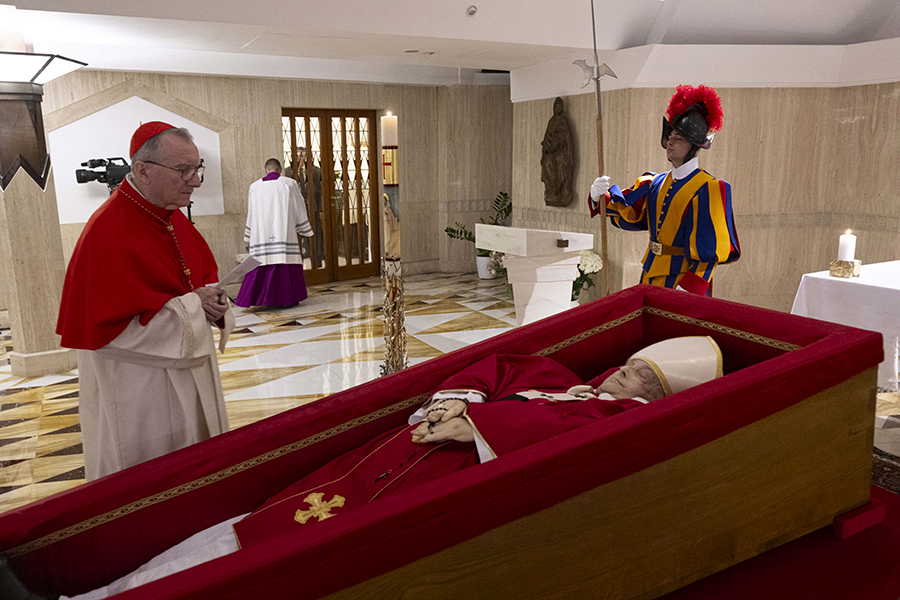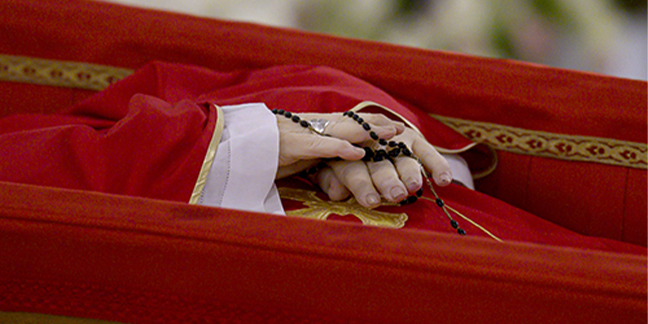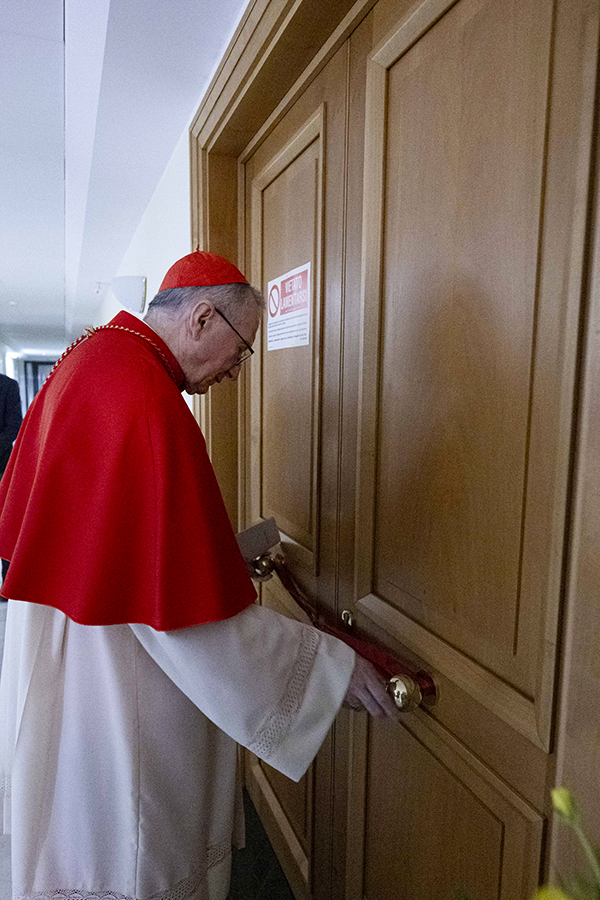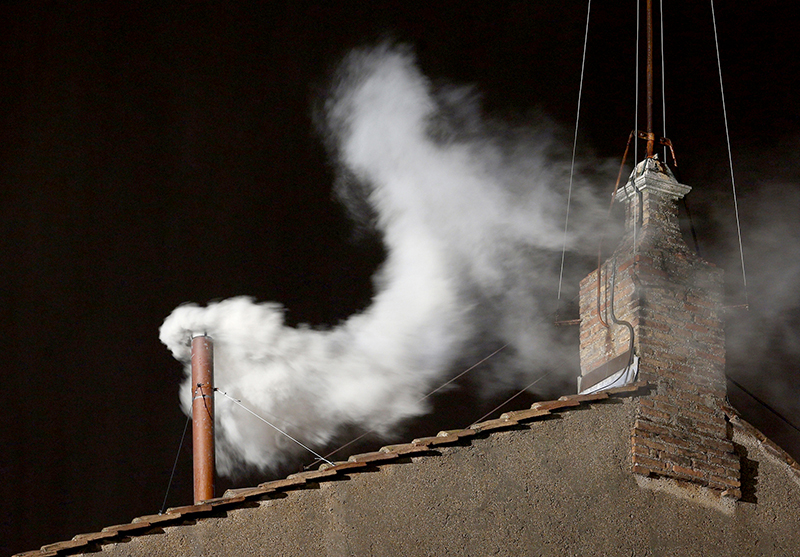
VATICAN CITY — The funeral Mass of Pope Francis will be celebrated April 26 in St. Peter's Square, the Vatican announced.
Cardinal Giovanni Battista Re, dean of the College of Cardinals, will preside over the liturgy, which begins a nine-day period of official mourning and daily memorial Masses.
The deceased pope's body, which was taken to the chapel of his residence late April 21, the day of his death, will be carried into St. Peter's Basilica for public viewing and prayer early April 23.
The public viewing was scheduled to end late April 25 with another prayer service to close the coffin.
The rites and rituals for dressing the body, moving it to St. Peter's Basilica and celebrating the funeral are published in the "Ordo Exsequiarum Romani Pontificis" ("Funeral Rites of the Roman Pontiff").
The rites originally were approved by St. John Paul II in 1998 but were released only when he died in 2005. Modified versions of the rites were used after Pope Benedict XVI died Dec. 31, 2022, and Pope Francis revised and simplified them in 2024.
 The hands of Pope Francis, holding a rosary, are seen as he lies at rest in his coffin in the chapel of his residence, the Domus Sanctae Marthae, at the Vatican April 21. (CNS/Vatican Media)
The hands of Pope Francis, holding a rosary, are seen as he lies at rest in his coffin in the chapel of his residence, the Domus Sanctae Marthae, at the Vatican April 21. (CNS/Vatican Media)
U.S. Cardinal Kevin J. Farrell, the chamberlain of the Holy Roman Church, presided over a prayer service for the formal verification of the pope's death April 21 in the chapel of the Domus Sanctae Marthae, where Pope Francis celebrated an early morning Mass most days before his final illness.
Cardinal Farrell will lead the prayerful procession to take the pope's body, already in its coffin, from the chapel, into St. Peter's Square and then into the basilica.
According to the book of rites, he will say, "Dearest brothers and sisters, with great emotion we accompany the mortal remains of our Pope Francis into the Vatican basilica where he often exercised his ministry as the bishop of the church that is in Rome and as pastor of the universal church."
— Cindy Wooden, Catholic News Service
Pictured at top: Cardinal Pietro Parolin, who served as Pope Francis' secretary of state, stands by the pope's coffin in the chapel of his residence, the Domus Sanctae Marthae, at the Vatican April 21, 2025. (CNS/Vatican Media)
More
Cardinals hold first meeting after pope's death
-
Cardinals hold first meeting after pope's death
 Cardinal Pietro Parolin, who served as Pope Francis' secretary of state, checks the seals on one of the doors of the suite of rooms used by Pope Francis in the Domus Sanctae Marthae, at the Vatican April 21. (CNS/Vatican Media)VATICAN CITY — Cardinals already present in Rome and those who were able to get to the city after Pope Francis' death April 21 held their first meeting at the Vatican April 22.
Cardinal Pietro Parolin, who served as Pope Francis' secretary of state, checks the seals on one of the doors of the suite of rooms used by Pope Francis in the Domus Sanctae Marthae, at the Vatican April 21. (CNS/Vatican Media)VATICAN CITY — Cardinals already present in Rome and those who were able to get to the city after Pope Francis' death April 21 held their first meeting at the Vatican April 22.About 60 cardinals met in the Vatican Synod Hall at 9 a.m. to decide when to move the pope's body from the chapel of his residence to St. Peter's Basilica and when to hold the funeral, Matteo Bruni, head of the Vatican press office told reporters.
They decided the funeral Mass of Pope Francis will be celebrated April 26 in St. Peter's Square after the deceased pope's body is taken into St. Peter's Basilica for public viewing and prayer early April 23. The public viewing was scheduled to end late April 25 with another prayer service to close the coffin.
During the cardinals' meeting, which lasted about an hour and a half, the cardinals also drew lots to determine the three cardinals who will serve a three-day term to assist the chamberlain of the church, U.S. Cardinal Kevin J. Farrell, with the general governance of the church during the period without a pope.
The three cardinals chosen April 22 were Italian Cardinal Pietro Parolin, former Vatican secretary of state; Polish Cardinal Stanislaw Rylko, archpriest of Rome's Basilica di St. Mary Major; and Italian Cardinal Fabio Baggio, undersecretary of the Dicastery for Promoting Integral Human Development. After three days, cardinals present in Rome will draw lots once again for the three cardinals to serve the next three-day term, Bruni said.
The meeting began with a prayer of suffrage for the pope and a reading of the "Adsumus, Sancte Spiritus," a prayer invoking the grace of the Holy Spirit for an assembly, he said.
Paragraphs 12 and 13 of the apostolic constitution, "Universi Dominici Gregis," were read, offering guidance on how the formal pre-conclave meetings of cardinals, called general congregations, will work. They read aloud the oath written in paragraph 12 that is taken by cardinals entering the general congregations, Bruni said.
Cardinal Farrell also read aloud Pope Francis' brief final testament in which he had asked to be buried at Rome's Basilica of St. Mary Major and had offered his suffering for peace in the world.
The cardinals also decided that all beatifications that had been scheduled are postponed until the next pope decides the new date for the ceremonies.
Many cardinals arrived at the Synod Hall at the Vatican through a back entrance, while just a few passed through the Petriano entrance to the Vatican next to St. Peter's Square and the flock of journalists crowding around it.
Among them was retired Italian Cardinal Gianfranco Ravasi who, at 82, is no longer eligible to vote in a conclave.
"The first meeting is less theoretical, it will be the ones that follow -- once cardinals arrive from all over the world -- that there will be indications on the points of view that will be taken up by who participates in the conclave, as happened in 2013," he told reporters before entering the Vatican.
The first meeting of cardinals "is more organizational," focusing on the ceremonies associated with a papal death, he explained, "also because Pope Francis wanted them to be simplified and calmer."
The cardinal said that Pope Francis' decision to be buried in the Basilica of St. Mary Major "with a particular simplicity" is a kind of "final message that he gives, above all recalling that he wanted to be buried in the shadow of a woman, in this case Mary, and this is significant also for the desire that the church do more for women."
Cardinal Ravasi, who was president of the Pontifical Council for Culture from 2007-2022, said the late pope had an "instinctive sensibility regarding contemporary culture," particularly in cultural matters concerning women, young people, science and technology, including artificial intelligence, and communications.
"He was above all someone who was innovative with the language of the church itself," the cardinal said, recalling phrases the pope would often invoke: "Third World War in piecemeal, the smell of the sheep, the field hospital."
"All of these expressions were very influential and allowed people to feel directly and immediately in sync" with the church, he said.
The next closed-door meeting for all cardinals who are able to be in Rome will be April 23 in the afternoon, Bruni said.
The faithful were invited to gather in St. Peter's Square to pray the rosary for the repose of Pope Francis' soul led by Cardinal Mauro Gambetti, archpriest of St. Peter's Basilica, at 7:30 p.m. local time April 22.
— Carol Glatz and Justin McLellan, Catholic News Service
A lasting legacy:
The Diocese of Charlotte prays:
- Two bishops and diocese unite in prayer for Pope Francis
- Words of prayer, comfort offered after news of pope’s death
- Bishop Martin, others reflect on the life and legacy of Pope Francis
What happens next:
- Prayer, pilgrims accompany pope's body to basilica
- Funeral for Pope Francis set for Saturday
- What happens next?
- Crowds gather to pray the rosary for repose of pope's soul
- In final testament, pope asks for simple burial, prayed for peace
Pope Francis’ legacy:
- Pope Francis: A pope of surprises to the very end
- The best of Francis: Five unforgettable moments
- Pope Francis dies during Jubilee, leaving Holy Door open in papal first
- Synods and synodality: Pope Francis' method and vision for the church
- Global pastor: In word and deed, pope preached mercy, outreach
- With pastor's touch, Pope Francis preached mercy, embraced 'peripheries'
- Documents: Pope wrote Curia reform, four encyclicals, six exhortations
- Pope dealt with breathing difficulty, abdominal surgery, mobility issues
- Pope's life, leadership, placed Latin America at center of the church
- While holding line on priesthood, Pope Francis promoted women's roles
- Pope Francis' was a pontificate of personal, practical ecumenism
- Pope Francis lived up to his namesake's love, care for creation
- Pope Francis remembered for lasting mark on church's marriage and family ministry
The world prays:
- 'Everyone was a child of God': Faithful recall Pope Francis' 2015 US visit
- White House, US political leaders react to death of Pope Francis
- US bishops honor Pope Francis' legacy in hours after his death
- Religious leaders remember Pope Francis as champion of dialogue
- Pope was a pastor first, which is lasting gift to church
- World leaders remember Pope Francis as an important international player
Special terms used during the period between popes
-
 White smoke billows from the chimney of the Sistine Chapel March 13, 2013, at the Vatican. Argentine Cardinal Jorge Mario Bergoglio, now Pope Francis, was elected the 266th Roman Catholic pontiff. Details surrounding the pope's election and other events can be found in the Vatican's recently published annual report of activities in 2013. (CNS/Paul Haring)
White smoke billows from the chimney of the Sistine Chapel March 13, 2013, at the Vatican. Argentine Cardinal Jorge Mario Bergoglio, now Pope Francis, was elected the 266th Roman Catholic pontiff. Details surrounding the pope's election and other events can be found in the Vatican's recently published annual report of activities in 2013. (CNS/Paul Haring) Special terms used during the period between popes
VATICAN CITY — Here is an explanation of some of the terms and practices related to the time between the death of Pope Francis April 21 and the election of his successor.
"Sede vacante"
Dioceses are also called sees. The Latin for "when the see is vacant" is "sede vacante." When the vacant see is the pope's Diocese of Rome, all major church decisions, such as new legislation or the appointment of bishops, stop until a new pope is elected. Only ordinary business and matters that cannot be postponed can be conducted by the College of Cardinals.
Interregnum
The period between popes is called an interregnum -- between reigns -- even though St. Paul VI set aside many of the regal trappings of the papacy and references to a papal "reign" gradually fell into disuse. Pope Paul inaugurated his ministry in 1963 with a coronation, then set aside the papal tiara. It was the last time a pope wore the beehive-shaped tiara, a triple crown.
Conclave
A meeting of cardinals to elect a new pope is a conclave. The word -- from the Latin "cum clave" (with key) -- means under lock and key. In 1268, cardinals couldn't decide on a new pope. After nearly three years the people finally locked them up and cut their rations. The man elected, Pope Gregory X, ordered that in the future cardinals be sequestered from the start, and eventually the practice became normative.
Camerlengo
U.S. Cardinal Kevin J. Farrell, as camerlengo, or chamberlain of the Holy Roman Church, assisted by the vice chamberlain and a canonical adviser, is in charge of safeguarding the temporal goods of the church and its temporal rights during the interregnum. The chamberlain heads a three-member commission that oversees physical preparations for the conclave and leads what is called a "particular congregation" -- a group of three other cardinals chosen by lot -- to conduct the minor day-to-day business of the Vatican until a new pope is elected.
Dean of the College of Cardinals
Italian Cardinal Giovanni Battista Re is the current dean. As dean, he calls the cardinals to Rome and presides over their daily meetings before the conclave. Because Cardinal Re is over 80 and ineligible to enter the conclave, the dean's duties inside the Sistine Chapel will be handled by Cardinal Pietro Parolin, the top-ranking cardinal-bishop of those under 80. Inside the chapel, Cardinal Parolin will administer the oath of secrecy and preside over the conclave. When a candidate achieves a two-thirds majority vote, Cardinal Parolin -- in the name of the entire college -- asks the candidate if he accepts the election and what name he will take.
Cardinal-electors
Only cardinals under the age of 80 on the day the "sede vacante" begins can enter a conclave and vote for a pope. Even if he is retired from other church posts, if a cardinal is under 80 he is considered an active cardinal for the purposes of the conclave. As of April 21, the day of Pope Francis' death, there are 135 cardinal-electors.
General congregations
All cardinals who are able to go to Rome attend the general congregations, which are daily meetings in which the College of Cardinals prepares for a conclave, discusses the needs of the church and handles more serious church business that must be attended to between popes. Cardinals over 80 may participate in these meetings but they are not required to. General congregations end when the cardinals enter into conclave.
Particular congregations
Between popes, the church's camerlengo and three other cardinals chosen by lot handle the day-to-day business of the Holy See in daily meetings called particular congregations. These continue while the cardinals are in conclave. Every three days three new cardinals are chosen by lot to assist the camerlengo.
"Extra omnes"
The Latin command, "all outside," orders everyone who is not authorized to be in the Sistine Chapel during the conclave to leave before the conclave starts.
Secrecy
Cardinals take two oaths of secrecy not to reveal to anyone anything directly or indirectly related to the election of the pope. The first oath is taken the first day a cardinal joins the general congregation; the second, at the start of the conclave. The few non-cardinals authorized to assist the cardinals while they are in conclave also take an oath of secrecy.
Scrutineers
These are three cardinals, chosen by lot at the start of a conclave, to oversee the depositing of the marked, folded ballots for pope into an urn. They shake the urn, count the ballots to assure the number of votes and voters matches, then open each ballot and record and read aloud the name on it. They add the votes cast for each candidate to determine if a pope has been elected and handle the burning of the ballots and any notes taken by cardinals.
"Infirmieri"
Three cardinals are chosen by lot at the start of a conclave to oversee conclave voting by any cardinal-electors who are too ill or infirm to sit through the conclave sessions in the Sistine Chapel. On each ballot, after depositing their votes in an urn, they go together to the sick cardinals with blank ballots and a locked box in which the completed ballots can be placed through a slit. They return to the conclave and deliver the votes.
Revisers
Three cardinals, chosen by lot at the start of a conclave, recount and verify each round of balloting for the election of a pope.
White smoke, black smoke
The traditional signal, from a chimney on the roof of the Sistine Chapel, indicates whether a pope has been elected: Black smoke, no; white smoke, yes. The smoke is generated by burning conclave ballots and notes with chemicals to make the smoke the right color.
— Catholic News Service
Timeline of recent papal transitions
-
Timeline of recent papal transitions
VATICAN CITY — After the deaths or resignations of their predecessors, the last six popes have been elected within a fairly short period of time -- between two and three weeks.
-- St. John XXIII died June 3, 1963, and his funeral was held June 6. The conclave to choose his successor began June 19 and lasted two days. Cardinal Giovanni Battista Montini, who took the name Paul VI, was elected June 21. He was installed June 30.
-- St. Paul VI died Aug. 6, 1978, and his funeral was held Aug. 12. The conclave to choose his successor began Aug. 25. A day later, Aug. 26, the cardinals elected Cardinal Albino Luciani, who chose the name John Paul I. He was installed Sept. 3.
-- Blessed John Paul I died less than a month later, on Sept. 28, 1978, and his funeral was held Oct. 4. The conclave to choose his successor began Oct. 15 and Cardinal Karol Wojtyla was elected on the second day of voting, Oct. 16. Pope John Paul II was installed Oct. 22.
-- St. John Paul II died April 2, 2005, and his funeral was celebrated April 8. Under the leadership of its dean, Cardinal Joseph Ratzinger, the College of Cardinals entered the conclave April 18 and elected the dean as pope the next day. He took the name Pope Benedict XVI and inaugurated his pontificate April 24.
-- Pope Benedict XVI announced Feb. 11, 2013, that he was resigning effective Feb. 28. Most of the world's cardinals gathered in Rome in time to thank him for his service and almost immediately began their pre-conclave meetings. The electors solemnly entered the Sistine Chapel and began the conclave March 12. Cardinal Jorge Mario Bergoglio was elected March 13 on the fifth ballot and took the name Pope Francis. He inaugurated his papacy March 19.
Pope Benedict died Dec. 31, 2022, and Pope Francis presided at his funeral Jan. 5, 2023.
-- Pope Francis died April 21, and his funeral was scheduled for April 26. A date for the conclave had not been announced as of April 22.
— Catholic News Service




